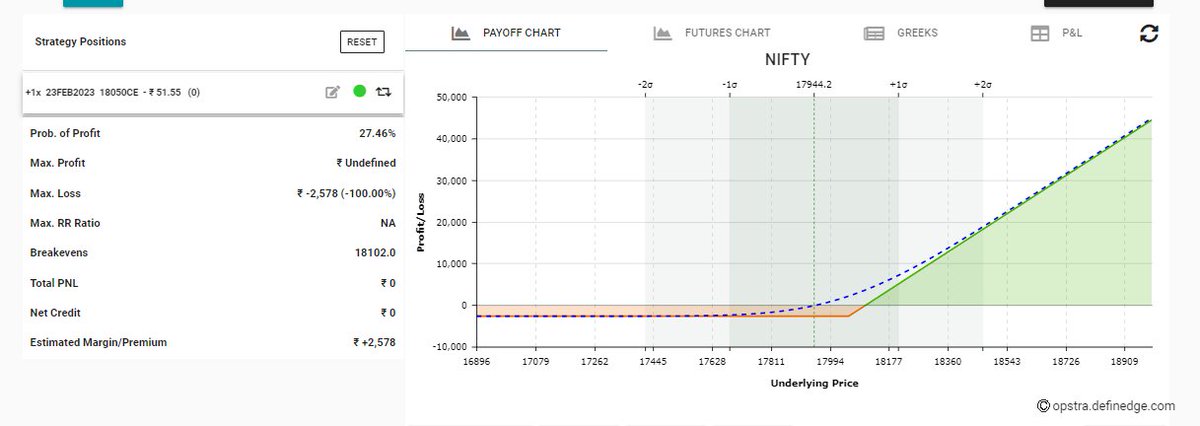Option buying is about capturing the momentum, hence sound knowledge of technical analysis is required.
Without any knowledge, if one is buying an option purely because he/she feels market will rise/fall is equivalent to buying lottery tickets.






Full Price Action Course in this thread \U0001f9f5
— Nikita Poojary (@niki_poojary) October 30, 2022
This course is worth 50k
Collaborated with @AdityaTodmal
Twitter is like a free university.
— Aditya Todmal (@AdityaTodmal) July 1, 2022
However, 98.8 percent of users missed out on the best content on this platform.
Here are the top 26 threads from the past 26 weeks of 2022: \U0001f9f5
Collaborated with @niki_poojary
I started at 0 and grew to 109,000 followers
— Aditya Todmal (@AdityaTodmal) July 3, 2022
Here's how we use Twitter and why:
Collaborated with @niki_poojary
THREAD \U0001f9f5 \u2193
Subasish Pani revealed the most simple, yet successful strategy: 5EMA set up!
— Nikita Poojary (@niki_poojary) July 3, 2022
Here is a thread of 23 video clips on the 5EMA set-up that will save you hundreds of hours and available to you for no cost!
5EMA set-up: \U0001f9f5!
Collaborated with @AdityaTodmal
There are so many tools related to trading.
— Aditya Todmal (@AdityaTodmal) July 9, 2022
But very few provide any real value.
Here are 7 of the most valuable FREE Tools you're not using (but should be): \U0001f9f5
Collaborated with @niki_poojary
Short Straddle is the highest payoff strategy in Option Selling.
— Aditya Todmal (@AdityaTodmal) November 5, 2022
However, it comes with huge risks as well.
You become good at managing Straddles with adjustments.
Here's a step-by-step breakdown on them:
Collaborated with @niki_poojary
\U0001f9f5
Things I know now that I wish I knew three years ago when I started trading.
— Nikita Poojary (@niki_poojary) November 5, 2022
Collaborated with @AdityaTodmal
\U0001f9f5
How to use a corporate account to lower taxes drastically
— Aditya Todmal (@AdityaTodmal) November 6, 2022
A comprehensive \U0001f9f5 :
Collaborated with @niki_poojary
10 most Powerful Intraday Setups with Screeners: \U0001f9f5
— Nikita Poojary (@niki_poojary) November 8, 2022
Collaborated with @AdityaTodmal
\U0001f3b2 How to play trigger watchlists \U0001f3b2
— Adam Sliver \U0001f3c0 (@AdamSliverTrade) October 10, 2021
1. How/When to enter:
This is NOT an exact science, there is no way to avoid fakeouts. These are KEY levels, and for that reason, provide strong moves. However, they can be hard to break due to their significance. You must manage risk.
\U0001f4daThread: How I Make Watchlists\U0001f4dd
— Adam Sliver \U0001f3c0 (@AdamSliverTrade) September 2, 2021
There are countless ways to make watchlists. Each trader looks for particular things in a setup that fits their style. There is no science here. My goal is to share a simplistic strategy on how to become SELF-SUFFICIENT with watchlists. \U0001f91d
\U0001f4c8How to use FinTwit to your advantage\U0001f4c8
— Adam Sliver \U0001f3c0 (@AdamSliverTrade) September 8, 2021
There\u2019s a lot of people that post great content on here. So I\u2019d like to share some of the best, and how you can use their strategies to add to your own playbook. \u2705
\U0001f4b8 Small Account Crypto Strategy \U0001f4b8 pic.twitter.com/4ULhsqsHxw
— Adam Sliver \U0001f3c0 (@AdamSliverTrade) September 20, 2021